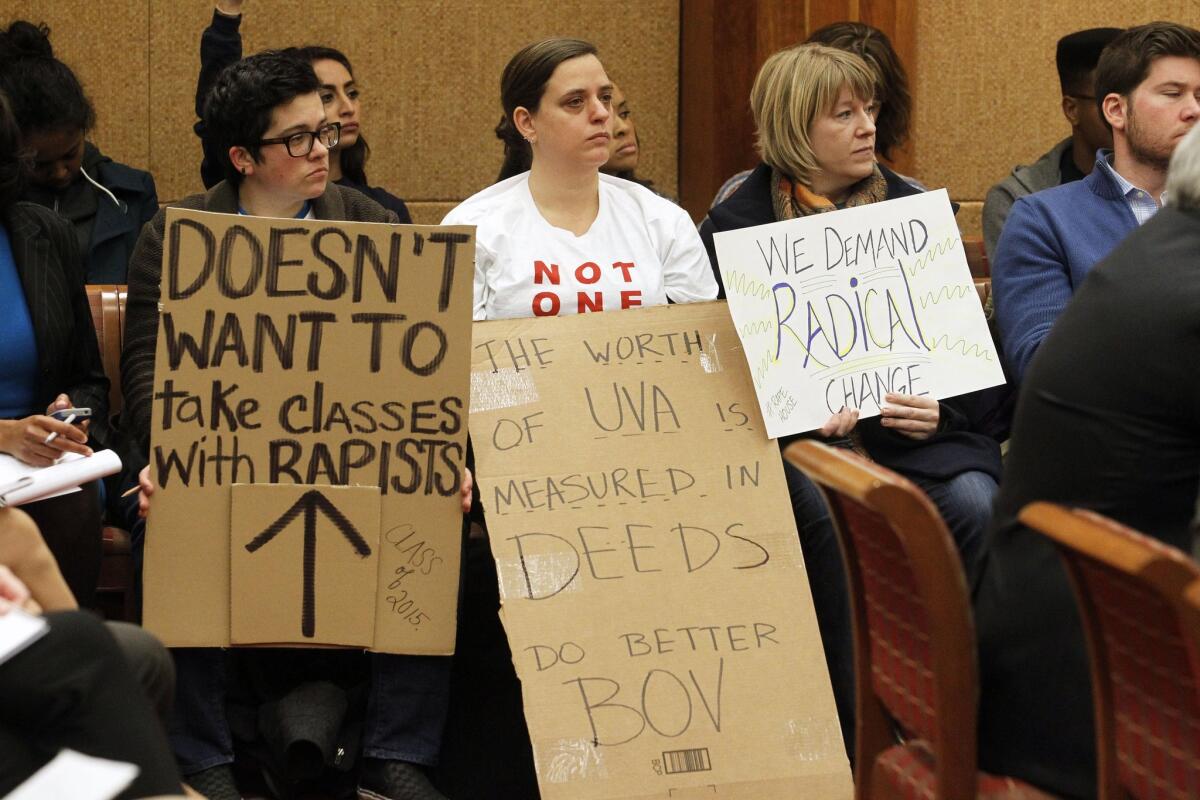Now more than ever, the issue of campus rape requires critical thinking

- Share via
Remember in 1986, when Newsweek supposedly showed that a 40-year-old single woman was “more likely to be killed by a terrorist” than to ever get married? It turned out to be false, the remark of a Newsweek correspondent, who’d meant it merely as a funny aside. And the studies on which it was presumably based? Flawed.
Nonetheless, until the magazine issued an official retraction 20 years later, that factoid occupied the murky space between conventional wisdom and urban myth. That is to say, it felt depressingly true and totally unbelievable — with an emphasis on felt. Regardless of the truth of the situation, the media and other parties cried wolf, which proved an effective in getting people’s attention. After all, the real figure — it turns out that single women older than 40 have about a 40% chance of marrying — didn’t have quite the same ring to it.
Today, another statistic is bandied about with similar abandon, and it concerns something much more serious than securing a husband. The phrase “1 in 5 college women will be sexually assaulted” over the course of their university enrollment has become absorbed into the lingua franca of gender politics and anti-rape advocacy. Even President Obama, who established a campus sexual assault prevention task force, rattles it off.
The problem is that there are about 12 million students currently enrolled in U.S. colleges, and the study that gave rise to that figure, the Campus Sexual Assault Study, published in 2007, sampled just under 5,500 of them from just two schools. In a Dec. 7 article that took an exhaustive look at this data, Slate’s Emily Yoffe quotes the study’s lead author, who insists that his findings do not amount to a nationally representative sample. Yoffe also points out that the survey’s definition of sexual assault covered everything from nonconsensual intercourse to “forced kissing,” “fondling” and “rubbing up against you in a sexual way, even if it is over your clothes.”
I’m not going to get into whether or how these behaviors may tip into something that should be defined as rape. Nor am I going to try to summarize Yoffe’s entire article, which should be required reading for anyone seeking to take part in this conversation. However, I will say, as the article points out, that sexual violence (or, if you prefer, accusations thereof or media fixations thereupon) isn’t the only scourge that’s epidemic on college campuses. Equally if not more insidious is a lack of critical thinking.
By defaulting to misleading statistics and championing logic such as “believe the survivor no matter what,” a troubling number of students appear to be missing — or outright rejecting — one of the basic precepts of advanced education: learning to question the party line and form rational, independent judgments.
Yes, academia has always been associated with generous portions of liberal dogmatism. But today’s students seem to have unprecedented levels of disregard for things like legal due process and standard scholarly research or journalistic practice. A website called Know Your IX, created to educate students about their rights, even goes so far as to advise members of the media covering gender-based violence to not use words like “alleged” or “accuser,” to allow subjects to review articles before publication, and to not push survivors to answer questions that make them uncomfortable. Needless to say, writers who follow such directives stand a good chance of not reporting the whole story, perhaps to disastrous and counterproductive effect, not unlike the now infamous Rolling Stone article about gang rape at the University of Virginia.
Campus activists will maintain that because memory can be unreliable in sexual assault cases, because witnesses can be few-to-none and because statistics tell us that these incidents are common, it’s all the more important to value the accuser’s (pardon my language) account over that of the accused. But critical thinkers should know better than to stop there. They should know that exercising doubt is not necessarily the same as casting doubt. Getting the story right helps survivors prevail. And if students don’t understand this, they need to either pay more attention in class or get their money back.
Until then, the 1-in-5 statistic is likely to stick around. So much for higher learning.
mdaum@latimescolumnists.comTwitter: @meghan_daum
More to Read
Sign up for Essential California
The most important California stories and recommendations in your inbox every morning.
You may occasionally receive promotional content from the Los Angeles Times.














